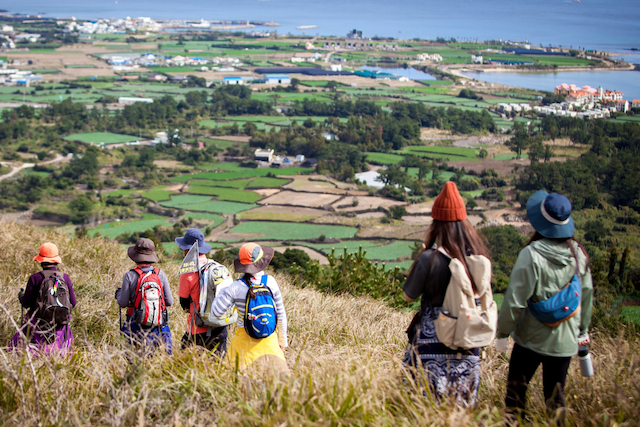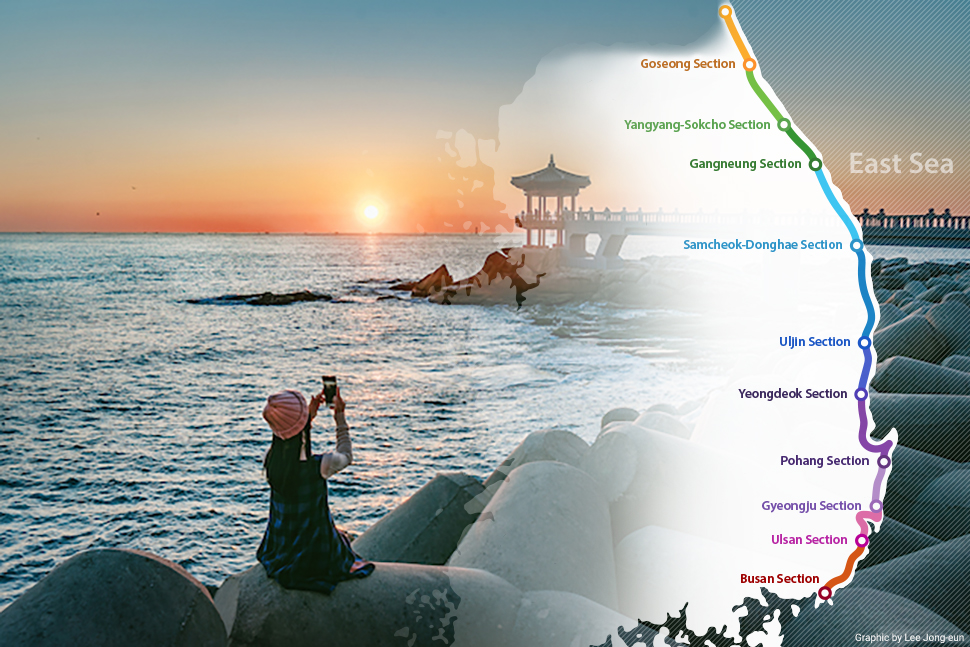[Feb] Trails that offer a glimpse of Korea’s nature
Date Feb 20, 2022
 Hikers walk along Jeju Olle Trail on Jeju Island. Courtesy of Jeju Olle Foundation
Hikers walk along Jeju Olle Trail on Jeju Island. Courtesy of Jeju Olle Foundation
Sitting on a peninsula where river valleys and coastal plains are tucked into the hills and mountains that cover about 70 percent of its land area, Korea boasts a diverse landscape.
Consequently, the country offers a variety of trails where avid hikers can experience captivating landscapes and unique attractions. Here are some of the footpaths that lead to Korea’s must-see destinations.
Haeparang Trail
Haeparang Trail starts from Oryukdo Sunrise Park in the southern port city of Busan and stretches about 770 kilometers north along the east coast up to Goseong Unification Observation Tower, located in Goseong, Gangwon-do Province.
The trail consists of 10 sections that pass Busan, Ulsan, Gyeongju, Pohang, Yeongdeok, Uljin, Samcheok, Gangneung, Yangyang and Goseong. Comprising a total of 50 courses, it offers diverse coastal scenery from white sandy beaches with a distinctive blue hue to forest trails near rocky seashores.
The uninterrupted trail passes through various well-known tour sites like Busan’s Gwangalli Beach and Pohang’s Homigot Sunrise Square – the easternmost end of the Korean peninsula. It also includes hidden gems like Ulsan’s seaside Daewangam Park with its pine forest and Goseong’s serene Cheonggan Beach, which features a pavilion perched on a seaside cliff.
For more information, visit: https://haeparanggil.com/services/index
 Haeparang Trail map / Courtesy of Korea Tourism Organization
Haeparang Trail map / Courtesy of Korea Tourism Organization
Seoul Trail
Korea’s capital Seoul also has a trail that allows hikers to grasp the metropolis in full: from its history and culture to its refreshing nature.
The 157-km loop trail comprises eight courses that circle the outer perimeter of Seoul. It runs through various mountains, including Bukhansan and Umyeonsan, so hikers can enjoy stunning cityscapes, as well as the sights along streams, the Hangang River and local neighborhoods.
The courses also include historical places like the Tomb of King Yeonsangun and Seooreung Royal Tomb and a few temples, such as Suguksa, Gwaneumsa, and Hoapsa.
For more information (Eng, Kor, Jpn, Chi) visit: https://english.seoul.go.kr/service/amusement/seoul-trail/01-seoul-trail/
Jeju Olle Trail
Jeju Island, Korea’s major tourist getaway located about 83 kilometers off the southern coast, is widely known for its Jeju Olle Trail that goes completely around the entire volcanic island.
The 425-km trail, containing 26 routes, provides beautiful scenery – the island’s vivid green landscapes bordered by crystal blue seas – and a glimpse of the lifestyles of its rural residents. It passes a handful of tourist spots, such as Jeju Oreum, a small, cone-shaped defunct volcano, and Hallasan, which sits inside a designated national park.
The mix of routes offer different island experiences. For example, Route 7 on the southern coast boasts a breathtaking coastal view and Route 18 on the northern coast gives a local vibe, passing Jeju Dongmun Traditional Market, which is the largest and oldest market on the island.
For more information (Eng, Kor) visit: https://www.jejuolle.org/trail/eng/
Gurye Seomjingang Cherry Blossom Trail
With spring just around the corner, it's almost time for cherry blossom season when certain avenues explode with pink and white blossoms.
Gurye Seomjingang Cherry Blossom Trail is a lesser-known spot for enjoying the flowers. It stretches about 59 kilometers along the Seomgjingang with cherry trees adorning both sides of the river.
The trail was recognized as one of the "100 Most Beautiful Roads in Korea" by the Ministry of Land, Infrastructure and Transport, and can be traveled both by foot or car.
For more information (Eng, Kor, Jpn, Chi) visit: https://www.gurye.go.kr/en/subPage.do?
**If you have any questions about this article, feel free to contact us at kocis@korea.kr.**

The Ministry of Culture, Sports and Tourism's "Korea Here & Now" work can be used under the condition of "Public Nuri Type 1 (Source Indication)."




